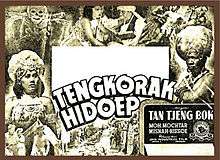Tengkorak Hidoep
Tengkorak Hidoep (literally The Living Skeleton) is a 1941 film from the Dutch East Indies (now Indonesia) directed by Tan Tjoei Hock. It has been called Indonesia's first domestic horror film.
| Tengkorak Hidoep | |
|---|---|
 Poster | |
| Directed by | Tan Tjoei Hock |
| Produced by | The Teng Chun |
| Written by | Tan Tjoei Hock |
| Starring |
|
| Cinematography | Tan Tjoei Hock |
Production company | Action Film |
Release date |
|
| Country | Dutch East Indies |
| Language | Malay |
Plot
Raden Darmadji and several of his friends go to the island of Mustika in search of Darmadji's brother, who was lost in a shipwreck ten years earlier. There, they discover that the god Maha Daru, who was locked away on the island 2,000 years before after losing a battle to the goddess Gumba. Darmadji, while exploring a cave, notices a huge rain storm. The earth rips asunder and Maha Daru escapes his prison.
As Darmadji tries to escape the cage, he is accosted by savage men and supernatural beings. His daughter, Rumiati, is also caught up in this apocalypse but seemingly rescued by Maha Daru. However, Maha Daru's ill-will towards Rumiati – whom he considers a reincarnation of Gumba – is soon made clear. A man living in the jungle rescues her, and they fall in love.[1]
Production
The black-and-white film was written, shot, and directed by Tan Tjoei Hock, with Java Industrial Film's The Teng Chun as producer;[1] it was Tan's last film as director.[2] It starred Tan Tjeng Bok, Moh Mochtar, Misnahati, and Bissu.[1]
Salim Said, writing in 1981, stated that Tengkorak Hidoep was influenced by previous film adaptations of Bram Stoker's Dracula,[3] while Ade Irwansyah of Tabloid Bintang suggested that the dominance of the jungle scenes was inspired by the various films centred on Edgar Rice Burroughs's Tarzan.[4]
Release and reception
Tengkorak Hidoep was released in 1941 and reportedly a commercial success.[1] Tan credited this success on the film's special effects, including a scene in which lightning smashes Maha Daru's grave and he comes out, a living skull, surrounded by flames.[2] A 35 mm copy of the film is reportedly stored at Sinematek Indonesia in Jakarta.[1]
Several articles, including one in the Indonesian film magazine F and the entertainment publication Tabloid Bintang, write that Tengkorak Hidoep was the first Indonesian horror film.[4] However, other publications, such as JB Kristanto's Katalog Film Indonesia (Indonesian Film Catalogue), consider the 1971 psychological horror film Lisa the first true Indonesian horror film;[4] in Kristanto's catalogue, Tengkorak Hidoep is considered an adventure film.[1] By the late 2000s, horror films had become one of the dominant genres in the Indonesian film industry.[4]
References
Footnotes
- Filmindonesia.or.id, Tengkorak Hidoep.
- Biran 2009, p. 281.
- Said 1982, p. 30.
- Irwansyah 2011, Tahukah Anda.
Bibliography
- Biran, Misbach Yusa (2009). Sejarah Film 1900–1950: Bikin Film di Jawa [History of Film 1900–1950: Making Films in Java] (in Indonesian). Komunitas Bamboo working with the Jakarta Art Council. ISBN 978-979-3731-58-2.CS1 maint: ref=harv (link)
- Irwansyah, Ade (30 October 2011). "Tahukah Anda: Apa Film Horor Indonesia Pertama?" [Did You Know: The First Indonesian Horror Film?]. Tabloid Bintang (in Indonesian). Jakarta. Archived from the original on 26 September 2012. Retrieved 26 September 2012.
- Said, Salim (1982). Profil Dunia Film Indonesia [Profile of Indonesian Cinema] (in Indonesian). Jakarta: Grafiti Pers. OCLC 9507803.CS1 maint: ref=harv (link)
- "Tengkorak Hidoep". filmindonesia.or.id (in Indonesian). Jakarta: Konfidan Foundation. Archived from the original on 27 July 2012. Retrieved 27 July 2012.